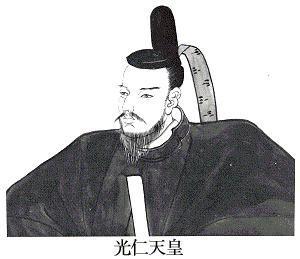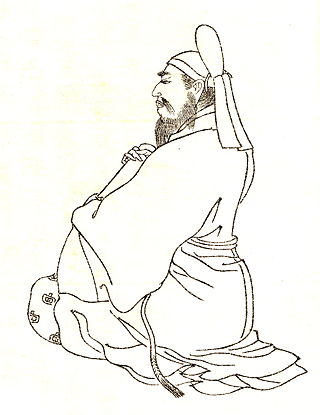Related Research Articles

Emperor Kōnin was the 49th emperor of Japan, according to the traditional order of succession. Kōnin's reign lasted from 770 to 781.

Ōtomo no Yakamochi was a Japanese statesman and waka poet in the Nara period. He was one of the Man'yō no Go-taika, the five great poets of his time, and was part of Fujiwara no Kintō's Thirty-six Poetry Immortals.

Ki no Tsurayuki was a Japanese author, poet and court noble of the Heian period. He is best known as the principal compiler of the Kokin Wakashū, also writing its Japanese Preface, and as a possible author of the Tosa Diary, although this was published anonymously. He is well known for his waka poetry and is counted as one of the Thirty-six Poetry Immortals selected by Fujiwara no Kintō; his poetry was included also in the Hyakunin Isshu. As a courtier, he served as Governor of Tosa (930-935), Vice Governor of Kaga (917-923) and Vice Governor of Mino Province (918-923).

Kennin (建仁) was a Japanese era name after Shōji and before Genkyū. This period spanned the years from February 1201 through February 1204. The reigning emperor was Tsuchimikado-tennō (土御門天皇).

Fujiwara no Morosuke, also known as Kujō-dono or Bōjō-udaijin, was a Japanese statesman, courtier and politician during the middle Heian period. Considered a learned scholar and well-versed in the customs of the court, he supported the court's government as udaijin during the reign of Emperor Murakami. Morosuke's eldest daughter Fujiwara no Anshi, empress consort to Emperor Murakami, gave birth to two princes who later became Emperor Reizei and Emperor En'yū, putting Morosuke's lineage in an advantageous position as the maternal relatives of the Emperor.

Fujiwara no Umakai was a Japanese statesman, courtier, general and politician during the Nara period. The third son of Fujiwara no Fuhito, he founded the Shikike ("Ceremonials") branch of the Fujiwara clan.
Fujiwara no Hamanari was a Japanese noble and poet of the Nara period. He was the son of Fujiwara no Maro, and, according to the genealogy book Sonpi Bunmyaku, his mother was Uneme of Yakami no Kōri, Inaba Province, who is probably the same person who had a famous affair with Aki no Ōkimi. The collection of Japanese poems Man'yōshū does not include his works. With an unknown woman he had a son Toyohiko (豊彦), among other children with other women. The footnote of Sonpi Bunmyaku, however, notes that Toyohiko is actually the grandson of Hamanari. Hamanari achieved the court rank of ju san-mi (従三位) and the position of sangi.

Fujiwara no Momokawa was a Japanese statesman, courtier and politician during the Nara period. His original name was Odamaro (雄田麻呂).

The Fujiwara no Hirotsugu rebellion was an unsuccessful Nara period rebellion led by Fujiwara no Hirotsugu (藤原広嗣) in the Japanese islands, in the year 740. Hirotsugu, dissatisfied with the political powers, raised an army in Dazaifu, Kyushu but was defeated by government forces.

Isonokami no Maro was a Japanese statesman of the Asuka period and early Nara period His family name was Mononobe no Muraji, later Mononobe no Ason and Isonokami no Ason. He attained the court rank of shō ni-i (正二位) and sadaijin, and posthumously ju ichi-i (従一位).
Kume may refer to:
Fujiwara no Yoshitsugu was a Japanese statesman, courtier, and politician of the Nara period. He was the second son of the founder of the Shikike branch of the Fujiwara, Fujiwara no Umakai. His original name was Sukunamaro (宿奈麻呂). He was the maternal grandfather of the emperors Heizei and Saga.

Fujiwara no Nagate was a Japanese court noble and statesman of the Nara period. He was the second son of the founder of the Hokke House of the Fujiwara clan, the sangi Fujiwara no Fusasaki. He achieved the court rank of Senior First Rank and the position of Minister of the Left, and posthumously of Chancellor of the Realm. He was also known as Nagaoka-Daijin (長岡大臣).

Fujiwara no Matate was a Japanese court noble and statesman of the Nara period. He was the third son of the founder of the Hokke House of the Fujiwara clan, the sangi Fujiwara no Fusasaki. He achieved the court rank of Senior Third Rank and the position of dainagon, and posthumously of daijō-daijin. His original name was Yatsuka (八束).

Fujiwara no Korekimi was a Japanese aristocrat and statesman of the Nara period. He reached the court rank of Junior Second Rank and the position of Minister of the Right (udaijin), and was posthumously promoted to Junior First Rank. He was also called Ushiya-daijin (牛屋大臣).

Isonokami no Yakatsugu was a Japanese noble and scholar of the late Nara period. He was the grandson of the sadaijin Isonokami no Maro and son of the chūnagon Isonokami no Otomaro. Yakatsugu himself reached the court rank of shō san-mi (正三位) and the position of dainagon, and was posthumously awarded the rank of shō ni-i (正二位).
Isonokami no Otomaro was a Japanese noble and scholar of the Nara period. He was the son of sadaijin Isonokami no Maro. He reached the court rank of ju san-mi (従三位) and the position of chūnagon.
Fujiwara no Tanetsugu was a Japanese noble of the late Nara period. He was the grandson of the sangi Fujiwara no Umakai, the founder of the Fujiwara Shikike. He reached the court rank of shō san-mi (正三位) and the position of chūnagon. He was posthumously awarded the rank of shō ichi-i (正一位) and the position of daijō-daijin.

Ōnakatomi no Kiyomaro was a Japanese noble of the Nara period. Born the seventh son of the chūnagon Nakatomi no Omimaro of the Nakatomi clan, he changed his name and founded the Ōnakatomi clan. He reached the court rank of shō ni-i (正二位) and the position of udaijin.

Minamoto no Michichika was a Japanese noble and statesman of the late Heian period and early Kamakura period. Serving in the courts of seven different emperors, he brought the Murakami Genji to the peak of their success. He is also commonly known as Tsuchimikado Motochika, and in Sōtō Zen buddhism as Koga no Michichika.
References
- 1 2 No Moonlight in My Cup: Sinitic Poetry (Kanshi) from the Japanese Court, Eighth to the Twelfth Centuries. BRILL. 2019-01-21. p. 138. ISBN 978-90-04-38721-8.
- ↑ Rabinovitch, Judith N.; Bradstock, Timothy Roland (2005). Dance of the Butterflies: Chinese Poetry from the Japanese Court Tradition. East Asia Program, Cornell University. p. 235. ISBN 978-1-885445-25-4.